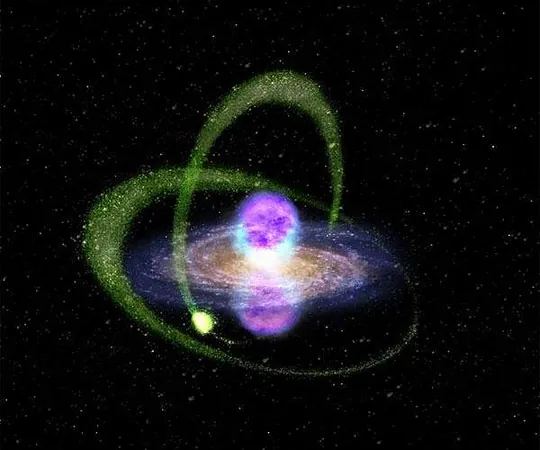
Unveiling the Milky Way's Secrets: Record-Breaking Gamma Rays Detected!
2024-10-27
Author: Li
Groundbreaking Discovery at the Milky Way Core
In a groundbreaking discovery, an international research team led by scientists from Los Alamos National Laboratory has detected the highest-energy gamma rays ever recorded at the core of our Milky Way galaxy. Conducted at the High-Altitude Water Cherenkov (HAWC) observatory, perched 13,000 feet above sea level on Mexico’s Sierra Negra volcano, this pioneering observation recorded gamma rays exceeding a staggering 100 teraelectron volts (TeV) for the first time, tracing their origins directly to the galactic center.
Scientific Insights and Implications
Pat Harding, a physicist from Los Alamos and principal investigator on the project, stated, "These results offer an unprecedented look at the Milky Way's center, showcasing energy levels an order of magnitude higher than ever previously observed." The discovery confirms the existence of PeVatrons—astrophysical structures capable of accelerating particles to energies measured in PeV (peta-electron volts).
Research and Observational Breakthroughs
The findings were compiled in a study led by researcher Sohyoun Yun-Carcamo and published in the Astrophysical Journal Letters. Over the past seven years, HAWC has detected nearly 100 high-energy gamma-ray events above the 100 TeV threshold, opening new pathways for cosmic research. This data allows scientists to delve deeper into cosmic ray interactions occurring within what is known as the Galactic Center Ridge, indicating that our galaxy is a hotspot for some of the universe's most intense physical processes.
Exploring the Energetic Environment
The area surrounding the galactic center is filled with extraordinary phenomena, hosting a supermassive black hole, neutron stars, and dense gas clouds heated to millions of degrees, making traditional observational methods ineffective in capturing these events. Instead, gamma-ray detection proves vital for probing this energetic and chaotic environment.
Understanding the PeVatron Phenomenon
The PeVatron phenomenon is still shrouded in mystery, but it is believed to be closely related to some of the universe's most violent occurrences, such as supernova explosions or the cataclysmic collisions of black holes. "Some of these processes are so rare one wouldn’t typically expect them to occur within our galaxy or occur on scales not representative of its size," Harding explained, suggesting that events like a black hole consuming another black hole are more likely to unfold beyond our galactic boundaries.
HAWC's Unique Detection Methods
HAWC's unique detection methods make it particularly adept at catching ultra-high-energy gamma rays traveling vast interstellar distances. The observatory employs 300 water-filled tanks equipped with photomultiplier detectors. When high-energy particles collide with Earth's atmosphere, they create cascades of secondary particles that generate Cherenkov radiation—a bluish glow that provides data for researchers. By studying the distribution of particles within the tanks, scientists can infer the energy levels and pinpoint the origins of the gamma rays.
Future Collaborations and Discoveries
Building upon previous research from the Milagro experiment near Los Alamos, the HAWC observatory's strategic relocation has significantly improved its capacity for capturing data from the galactic center. Future projects aim to expand upon these findings by collaborating with the Southern Wide-field Gamma-ray Observatory in Chile's Atacama Desert, where researchers hope to refine their understanding of PeVatrons and uncover more about the cosmic phenomena at the heart of our galaxy.
Conclusion: A Universe of Exploration Awaits
In a universe filled with wonders waiting to be explored, the Milky Way's core continues to reveal the secrets of energetic processes that shape the cosmos. Keep your eyes peeled for more updates as the findings unfold!





 Brasil (PT)
Brasil (PT)
 Canada (EN)
Canada (EN)
 Chile (ES)
Chile (ES)
 Česko (CS)
Česko (CS)
 대한민국 (KO)
대한민국 (KO)
 España (ES)
España (ES)
 France (FR)
France (FR)
 Hong Kong (EN)
Hong Kong (EN)
 Italia (IT)
Italia (IT)
 日本 (JA)
日本 (JA)
 Magyarország (HU)
Magyarország (HU)
 Norge (NO)
Norge (NO)
 Polska (PL)
Polska (PL)
 Schweiz (DE)
Schweiz (DE)
 Singapore (EN)
Singapore (EN)
 Sverige (SV)
Sverige (SV)
 Suomi (FI)
Suomi (FI)
 Türkiye (TR)
Türkiye (TR)
 الإمارات العربية المتحدة (AR)
الإمارات العربية المتحدة (AR)